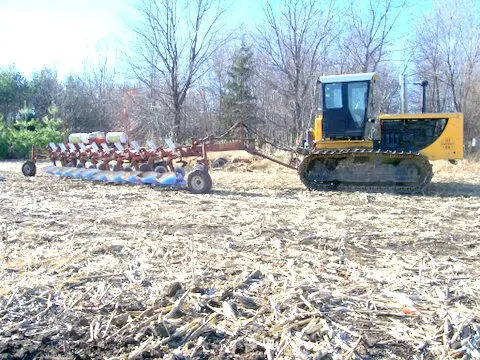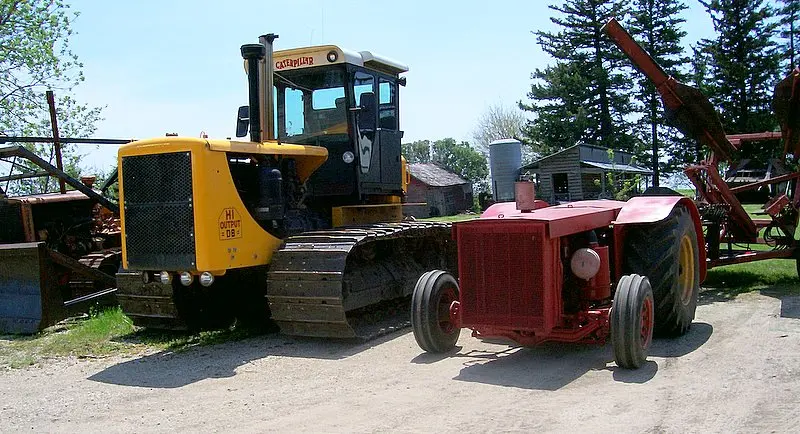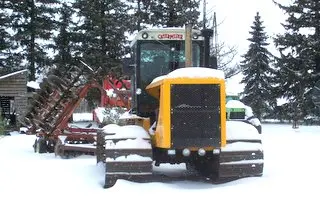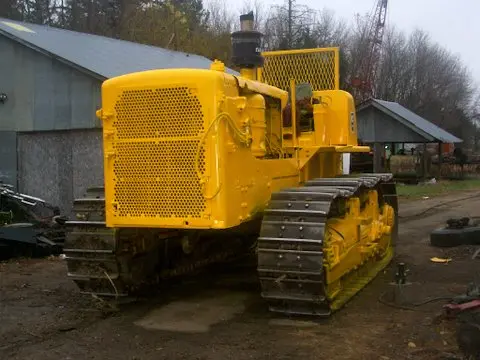You're going to need a lot of aluminum frame rail for that project. You'll have to visit every truck wrecker within a 500 mile radius to collect enough material to make that many track pads.
rounding up the al isn't much of my concern- going to the effort & finding out it's a loosing deal is what bothers me- would like to see if somebody has been der & done dat..[w/ success]theory is light wt pads = less Hp expended @ speed=better fuel economy- thinking bout running the 46A in road gear w field cult.. tank track is live & wants to go round sprokets- while cat is dead track & takes power to do same & speed compounds this.. wt of wide pads don't help either - but necessary so as not to smash my dirt..
Would oak planks be practical? (no pun intended!) I've seen wood added on top of factory grousers to increase floatation, was fairly common around the Delta here in CA at one time. Might work if they are not too much longer than the steel pad underneath, and should be somewhat less expensive.
I'm not quite sure I follow what you're using the tracks on, with regards to the tank and round sprokets, is this on a pull implement or a tractor??? Just a thought.
Lots of guys used to run channel iron bolted onto the factory grousers to add floatation. Those worked well and lasted a long time usually. The best way I can describe it is if you're looking at the grouser on the tractor, on the top surface (the part that touches the ground) the channel iron would be placed with the open "C" side touching the grouser, and the flat side of the channel touched the ground. Often the ends were cut and bent down then re-welded to roll the ends down some.
The other thing I've seen done to get more floatation/traction besides using a lighter tractor (D6 or D7 size) is extending the track frames longer, adding one or two rollers and lengthening the track rails.
For sure I'm no engineer, but I just don't see lightening the tractor as a way to increase fuel economy on something like a Caterpillar D8. For it to run efficiently, it should be pulling at or around its max capacity without being overtaxed. This is a function also of traction and that is weight. If you lighten it up enough to increase fuel economy, it probably won't pull enough width of implement to be efficient and you'll burn more diesel per acre anyways. Best to match the width/depth of implement to the tractor HP to optimize the fuel/acre used. Probably the best results would be from re-powering the tractor with a modern diesel engine with more efficient fuel injection system, but then you'd be spending more than what the extra fuel would cost for quite a while!!!




[quote="tailseat15"]
I'm not quite sure I follow what you're using the tracks on, with regards to the tank and round sprokets, is this on a pull implement or a tractor??? Just a thought.
For sure I'm no engineer, but I just don't see lightening the tractor as a way to increase fuel economy on something like a Caterpillar D8. For it to run efficiently, it should be pulling at or around its max capacity without being overtaxed. Best to match the width/depth of implement to the tractor HP to optimize the fuel/acre used. Probably the best results would be from re-powering the tractor with a modern diesel engine with more efficient fuel injection system, but then you'd be spending more than what the extra fuel would cost for quite a while!!![/quote]
Will try to splain---tank uses live track - if split it will roll up in ball = wants to go around the sprockets& idler -- while cat has dead track & requires effort to pull it around & back.. no big deal @ low speed- but as speed increases the HP required to just run the track gets out of hand- [I'v been in M60 tank 60mph- don't think dead steel track could hack that]- the deal is not lightning up the cat -- its trying to lighten up the track itself.........pulling cap is a a fallacy on the D8's or D7's w/ the 5 3/4 /8 low rpm eng-- my RD7's & 2U D8 use the same fuel on the same implement-[3 1/2 gal/ hr on old fuel & 4 gal/hr on new crap] they use what it takes to pull the load only- but kicking er up a gear takes a little more as the track starts to require more effort & imp is slapping dirt harder instead of being gentle bout it..---- dem new modern fuel efficient are really a joke- not a funny one either-- I had a 977 w one of those high and winders- 8 gal/ hr loading logs or plowing snow- [RD7 used bout 2 for same task]--my 2U D8 pulls the 10 bottom plow on 4 gal/hr @ 4mph & neighbors case IH pulls a 12 [10 was biggest I could find close]- no faster --but burns 35 gal/hr- give one of those new efficient ones NOT..😞----[shoes on 46A look a bit skimpy for farming]
Tank tracks, or High Speed tracks have smaller links, shorter pitches and are much more flexible. They are also much more complex (more parts per link) and require more maintenance. After dozer tracks have "broken in" they flex more easily so it doesn't take away as many horsies to drive them.
[quote="tailseat15"]
I'm not quite sure I follow what you're using the tracks on, with regards to the tank and round sprokets, is this on a pull implement or a tractor??? Just a thought.
For sure I'm no engineer, but I just don't see lightening the tractor as a way to increase fuel economy on something like a Caterpillar D8. For it to run efficiently, it should be pulling at or around its max capacity without being overtaxed. Best to match the width/depth of implement to the tractor HP to optimize the fuel/acre used. Probably the best results would be from re-powering the tractor with a modern diesel engine with more efficient fuel injection system, but then you'd be spending more than what the extra fuel would cost for quite a while!!![/quote]
Will try to splain---tank uses live track - if split it will roll up in ball = wants to go around the sprockets& idler -- while cat has dead track & requires effort to pull it around & back.. no big deal @ low speed- but as speed increases the HP required to just run the track gets out of hand- [I'v been in M60 tank 60mph- don't think dead steel track could hack that]- the deal is not lightning up the cat -- its trying to lighten up the track itself.........pulling cap is a a fallacy on the D8's or D7's w/ the 5 3/4 /8 low rpm eng-- my RD7's & 2U D8 use the same fuel on the same implement-[3 1/2 gal/ hr on old fuel & 4 gal/hr on new crap] they use what it takes to pull the load only- but kicking er up a gear takes a little more as the track starts to require more effort & imp is slapping dirt harder instead of being gentle bout it..---- dem new modern fuel efficient are really a joke- not a funny one either-- I had a 977 w one of those high and winders- 8 gal/ hr loading logs or plowing snow- [RD7 used bout 2 for same task]--my 2U D8 pulls the 10 bottom plow on 4 gal/hr @ 4mph & neighbors case IH pulls a 12 [10 was biggest I could find close]- no faster --but burns 35 gal/hr- give one of those new efficient ones NOT..😞----[shoes on 46A look a bit skimpy for farming]
Hmmm,, what is live vs dead track?
Also remember the work it takes to roll the track up around the sprocket is given back as the track goes down around the idler. From the standpoint of gravity9weight) there is no loss in the system.
Tank tracks, or High Speed tracks have smaller links, shorter pitches and are much more flexible. They are also much more complex (more parts per link) and require more maintenance. After dozer tracks have "broken in" they flex more easily so it doesn't take away as many horsies to drive them.